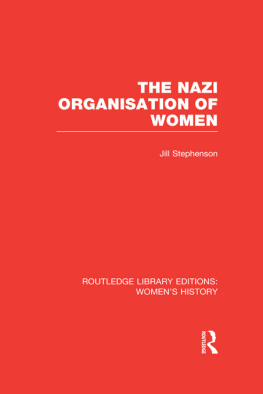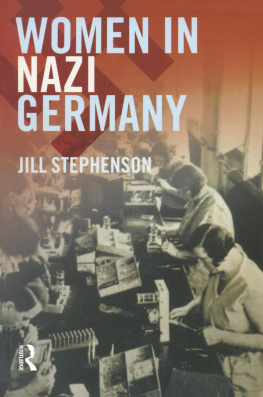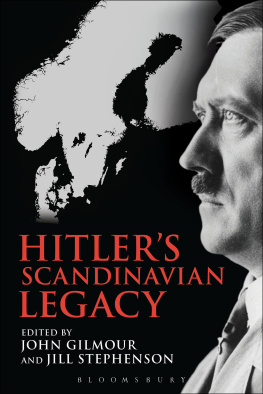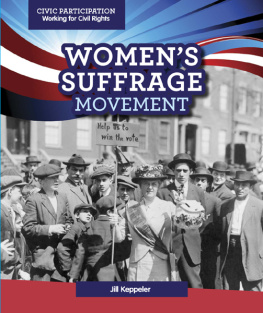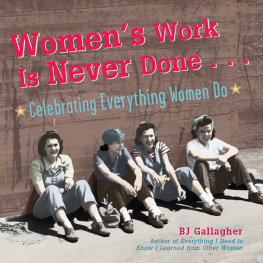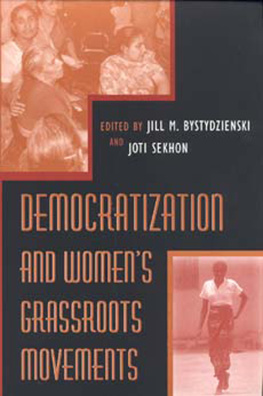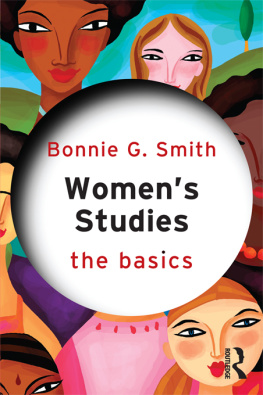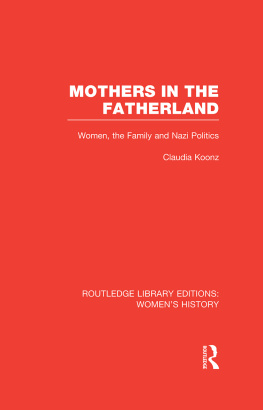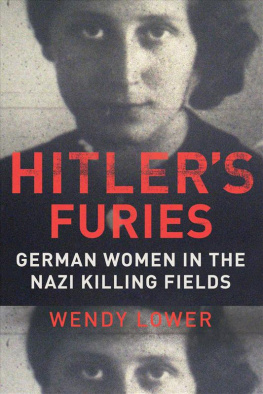Routledge Library Editions: Womens History
The Nazi Organisation of Women
First published in 1981
This edition first published in 2013
by Routledge
2 Park Square, Milton Park, Abingdon, Oxon, OX14 4RN
Simultaneously published in the USA and Canada
by Routledge
711 Third Avenue, New York, NY 10017
Routledge is an imprint of the Taylor & Francis Group, an informa business
1981 Jill Stephenson
All rights reserved. No part of this book may be reprinted or reproduced or utilised in any form or by any electronic, mechanical, or other means, now known or hereafter invented, including photocopying and recording, or in any information storage or retrieval system, without permission in writing from the publishers.
Trademark notice: Product or corporate names may be trademarks or registered trademarks, and are used only for identification and explanation without intent to infringe.
British Library Cataloguing in Publication Data
A catalogue record for this book is available from the British Library
ISBN: 978-0-415-53409-3 (Set)
eISBN: 978-0-203-10425-5 (Set)
ISBN: 978-0-415-62272- 1 (Volume 34)
eISBN: 978-0-203-10399- 9 (Volume 34)
Publishers Note
The publisher has gone to great lengths to ensure the quality of this reprint but points out that some imperfections in the original copies may be apparent.
Disclaimer
The publisher has made every effort to trace copyright holders and would welcome correspondence from those they have been unable to trace.
The Nazi Organisation of Women
JILL STEPHENSON
1981 Jill Stephenson
Croom Helm Ltd, 2-10 St Johns Road, London SW11
British Library Cataloguing in Publication Data
Stephenson, Jill
The Nazi organisation of women.
1. Nationalsozialistische Deutsche Arbeiter
Partei
2. Women Germany Societies and clubs
History - 20th century
3. Women in politics Germany History
20th century
I. Title
329.943 DD256.5
ISBN 0-85664-673-3
First published in the USA 1981 by
BARNES & NOBLE BOOKS
81 ADAMS DRIVE
TOTOWA, NEW JERSEY, 07512
ISBN 0-389-20113-8
Printed and bound in Great Britain by
Redwood Burn Limited
Trowbridge & Esher
For Steve
Contents
Acknowledgements
Glossary and List of Abbreviations
Acknowledgements
It is a pleasure to acknowledge the advice and assistance I have received from individuals and institutions while preparing this book. The main sources were made available by the Bundesarchiv, Koblenz, the Berlin Document Center and the Institut fur Zeitgeschichte in Munich; for access to their facilities I am most grateful. I would also like to thank the Hoover Institution, California, for sending me essential microfilm. My warmest thanks are due to the staff of the Wiener Library, London, for their unfailing hospitality as well as their invaluable help. Edinburgh University Library readily met many demands, particularly through its photographic and inter-library loan departments. For financial assistance to enable me to carry out research abroad and to utilise the documentary sources most efficiently, I am indebted to the Travel and Research Fund of Edinburgh University and also to the British Academy, which generously made me a grant. I received invaluable information and help from Dr Gisela Miller, Hamburg, and Dr Marta Baerlecken-Hechtle, Diisseldorf, and I am also grateful to Mrs Louise Willmot, Oxford, Conan Fischer, Heriot-Watt University, Dr Peter Stachura, Stirling University and Mrs Cecilia Smith, Edinburgh University, for their advice. Professor Dietrich Orlow and Professor W.S. Allen were kind enough to answer queries which I addressed to them. Once again I have trespassed on Professor V.G. Kiernans time; he generously read part of the text in draft. And, also, I owe a special debt to Mrs Sheila Somerville, for her patience as well as her efficient typing of the text. My husband, too, has shown patience, tolerating the domestic regime which this books completion has demanded. Its shortcomings are, of course, no ones responsibility but my own.
Introduction
This is not a history of the Nazi Party; others, on whom I have greatly depended, provide this. whose insights and appraisals are, not always but often enough, still valid today. But as a contemporary, pre-war study, Kirkpatricks is necessarily incomplete.
While this book aims to provide a more complete picture of the Nazi womens organisations from their start, in the early 1920s, until their end in 1945, its purpose is above all to contribute to the study of National Socialism as a movement which attracted and held the enthusiasm of a small minority of Germans who, given the chance from 1933, attempted to impose their will on the majority. The paradoxical character of the NSDAP, as a revolutionary force pledged to restore Germany to a mythical past from which it could develop towards an ideal present and future, attracted to it from 1919 those who wanted to return to the point where, they felt, Germany had taken a wrong turning. Unification in 1871 had been part of the correct development, yet again, in the Nazi view, endangering the future of the race. The quality of German life, too, was under threat, with women, the guardians of German culture, distracted by work, political agitation and the growth of a consumer society from their alleged age-old function of cherishing the nations distinctive songs, dances, costumes and crafts.
The Nazi revolution would restore women to the idyllic destiny from which they had been diverted before the First World War and which was, said the Nazis, deliberately derided by the Marxists, inter-nationalists, liberals and feminists who seemed, in the post-war period, to have emerged as the victors from Germanys pre-war political and social conflicts. And if women had been deflected from their destiny -which was only the fulfilment of the instinctive aspirations of the female nature, it was said even before the war, the experience of the war and the trauma of the revolutionary upheavals in a number of Germanys cities in 1918-19 convinced increasing numbers of men and women that the circumstances of post-war Germany would only intensify the distortion. The kind of changes that could be achieved to counteract modern evils through the new parliamentary system would do no more than tinker with the symptoms, for example, the filth that was given free rein in literature and drama by the lifting of censorship.
These sentiments contributed to the development of what may cautiously be called the Nazi view of womens role in the nation and in the Party. As Hans Frank was to say, there were as many National Socialisms as there were leaders,
While growing numbers of men were drawn to National Socialism in the 1920s because of these ideas among others, there were women, too, who found the Nazis traditionalist approach to womens role attractive. For them, it was enough to sympathise with and support the Partys fighting menfolk, and although small numbers of women joined the new local branches of the NSDAP which sprang up all over the country from the mid-1920s, most pro-Nazi women regarded it as inconsistent with their own and the Partys view of womens role to join a political party. But there were, almost paradoxically, a number of women with distinctly feminist views who gravitated to National Socialism because of its anti-Marxism, its ultra-nationalist and racist aspect, or for local or family reasons. It is clear that they either ignored the Partys pronouncements about womens role or else refused to take them seriously. In the critical years between 1930 and 1933 the Party gave them plenty of encouragement in their self-delusion at a time when its leadership was hoping to make a favourable impact on the female voter in its bid for power the legal way. Gregor Strasser, the Partys organisational chief at this time until his unexpected resignation in December 1932, particularly seemed to welcome and encourage womens participation in election campaigns. And so women supporters of National Socialism in the 1920s, up to 1933, might or might not wholeheartedly support the Partys general view of womens place in society, and might or might not be members of the NSDAP.

